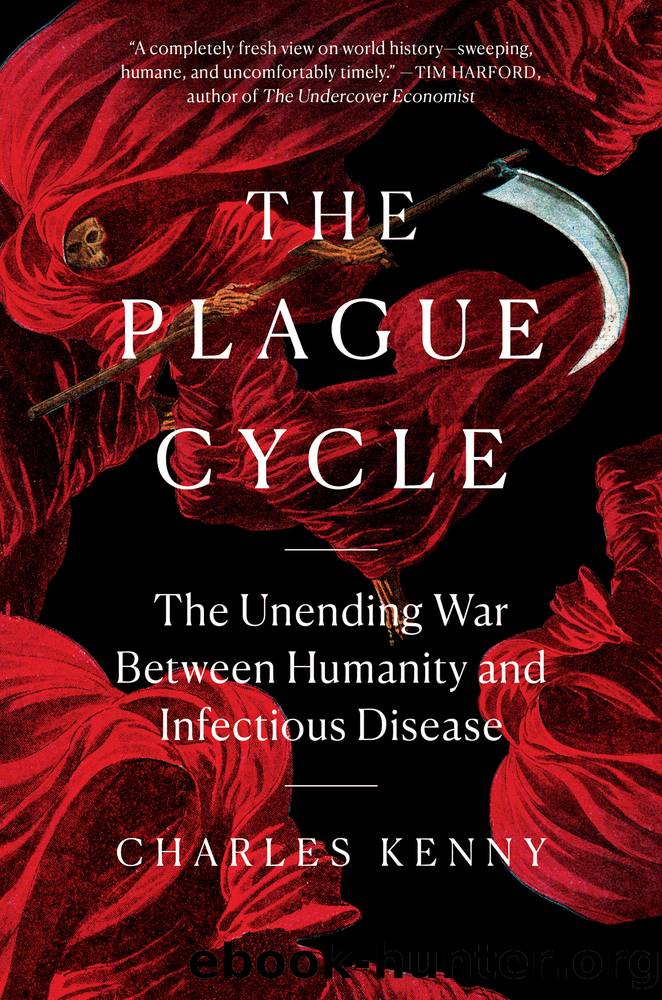The Plague Cycle by Charles Kenny

Author:Charles Kenny
Language: eng
Format: epub
Publisher: Scribner
Published: 2021-01-19T00:00:00+00:00
* * *
Evolutionary biologist Katherine Smith and colleagues at Brown University studied more than twelve thousand reported disease outbreaks worldwide since 1980 and concluded that both the number of diseases and the number of outbreaks have been increasing over time (though the good news is that the cases of illness in each outbreak have declined thanks to better surveillance, prevention, and treatment).10
Since 1970, weâve seen the emergence of new infections, including severe acute respiratory syndrome, avian influenza, Nipah virus, Hendra virus, Ebola, Marburg fever, Lassa fever, variant Creutzfeldt-Jakob disease, cryptosporidiosis, cyclosporiasis, Whitewater Arroyo virus, hantavirus, and (of course) Covid-19. Thatâs not to mention resurging or reemerging diseases, including multidrug-resistant tuberculosis, monkeypox, dengue and yellow fever, drug-resistant malaria, and even plague.11
Some new diseases emerge from forests as HIV did. The 1998 Malaysian Nipah virus epidemic demonstrated how the continued spread of human activity puts us in contact with new zoonotic illness: fruit bats carrying the disease were displaced by deforestation and ended up sharing fruit with pigs crammed into large pens near orchards. As the pigs trampled the fruit batâs droppings, they aerosolized the excrement, and breathed it in. The pigs were infected with the Nipah virus, which was then passed on to human handlers. The condition can cause swelling of the brain, coma, and deathâsometimes years after exposure.12 (Covid-19 also emerged from bats.)
Other diseases mutate and evolve from the existing stock of infections that accompany people and their livestock. Humans only reproduce after moreâoften considerably moreâthan a decade and a half of growth. The average virus produces thousands of offspring in one or two days.13 That means microbes can evolve a lot faster than their hosts.14 And even minor mutations can have dramatic implications. Rapid evolution is why previously (comparatively) unthreatening infections can quickly become big killers.15
Consider, for example, another recent outbreak: in the week of April 13, 2009, two unrelated children in Southern California fell ill, coughing, sneezing, and running a temperature. Both sets of parents took them to separate clinics. Both children were tested and found to have flu of an unidentified strain. The children went home with the usual assortment of drugs and both felt better within a week. But according to standard protocols, the United States Centers for Disease Control was alerted. On April 17, four days after the children had visited clinics, the CDC declared that the children had contracted a previously unknown flu virus, swine influenza A H1N1. It was labeled swine influenza because this was a strand that had jumped species from pigs to cause illness in humans. âConcern exists that⦠a large proportion of the population might be susceptible to infection, and that the seasonal influenza vaccine⦠might not provide protectionâ against the swine influenza variant, reported the CDC.16
By the end of the month, the World Health Organization had declared a global pandemic of swine flu. Mexico, at the epicenter of the outbreak, reported 949 laboratory-confirmed cases, including 42 people whoâd died of the disease. The country closed schools and banned large public gatherings.
Download
This site does not store any files on its server. We only index and link to content provided by other sites. Please contact the content providers to delete copyright contents if any and email us, we'll remove relevant links or contents immediately.
| Administration & Medicine Economics | Allied Health Professions |
| Basic Sciences | Dentistry |
| History | Medical Informatics |
| Medicine | Nursing |
| Pharmacology | Psychology |
| Research | Veterinary Medicine |
A History of the Human Brain by Bret Stetka(491)
The Spike by Mark Humphries;(463)
Basic Exercise Physiology by Moran S. Saghiv & Michael S. Sagiv(462)
The Plague Cycle by Charles Kenny(444)
The Whole-Body Microbiome by Brett Finlay & Jessica Finlay(420)
Virus Mania by Torsten Engelbrecht; Köhnlein Claus(397)
The Genetic Lottery by Kathryn Paige Harden(379)
Reviews of Physiology, Biochemistry and Pharmacology by Unknown(377)
Your Brain on Exercise by Gary L. Wenk(342)
Lymph & Longevity by Gerald Lemole(337)
Biophysics of Membrane Proteins by Unknown(325)
Soft-Wired: How the New Science of Brain Plasticity Can Change Your Life by Dr. Michael Merzenich Phd(294)
Fixing My Gaze by Susan R. Barry; Oliver Sacks(286)
Anatomy of the human body: Anatomy body part by Anik Ahmed(285)
Corona, False Alarm?: Facts and Figures by Karina Reiss && Sucharit Bhakdi(282)
Netter's Clinical Anatomy E-Book by John T. Hansen(279)
Structural Immunology by Unknown(253)
Essentials of Pathophysiology by Tommie L. Norris(243)
Brain Weaver, Volume 1 by Andrew Newberg(222)
